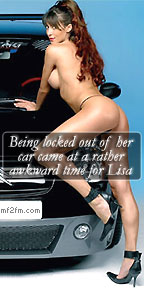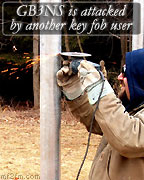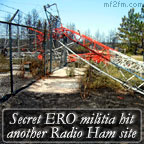Monday 10 March, 2008, 18:25 - Amateur Radio
Posted by Administrator
<rant> Whilst visiting Oxford this week, a quick scan around the 70cm band yielded a number of repeaters that aren't normally receiveable from my regular location. Amongst these was GB3WO, near Witney in Oxfordshire. Nothing unusual there. Except that upon setting the right CTCSS tone and firing up the repeater, it was distressing to find that it remained open and was emitting a horrid buzzing/whining noise like someone was attacking it with a chainsaw. The culprit for the noise was clearly one of the many low-power licence-exempt data links used for devices such as weather stations, doorbells and the like.Posted by Administrator
 I've already discussed the issue of allowing these devices into the UK 70cm repeater band and poor GB3WO was suffering the consequences (of course, the addition of a requirement for all transmissions to have CTCSS as some repeater operators have done would help the situation but would not stop the repeater input being jammed by such a device, only stop it being relayed). I've also recently highlighted the problems of being a secondary user in the 70cm band and the associated difficulties in getting interference dealt with.
I've already discussed the issue of allowing these devices into the UK 70cm repeater band and poor GB3WO was suffering the consequences (of course, the addition of a requirement for all transmissions to have CTCSS as some repeater operators have done would help the situation but would not stop the repeater input being jammed by such a device, only stop it being relayed). I've also recently highlighted the problems of being a secondary user in the 70cm band and the associated difficulties in getting interference dealt with. But it seems that the problem is getting even worse. Repeater GB3NS in Banstead, Surrey had to be taken off-air because of these low power devices. It used to operate on RB10 (output frequency of 433.250 MHz) but was forced to cease operation when it was shown that it was causing blocking of car key-fob receivers in a nearby car-park which was in turn causing the car rescue organisations to be repeatedly called out to cars that wouldn't open or start. It was eventually shown, following practical on-air tests, that a change to a 70cm wide-space (7.6 MHz split) channel assignment circumvented the problem and eventually 'NS was re-licensed and radio hams can now use this repeater again (output is on 430.925 MHz and input on 438.525 MHz which also keeps the input frequency thankfully free of these annoyances). So this is a real example of a secondary user of a band being forced to cease transmissions to protect a tertiary or non-interference basis 'NIB' user - clearly in this band, radio amateurs are not just second-class citizens but have no rights at all.
But it seems that the problem is getting even worse. Repeater GB3NS in Banstead, Surrey had to be taken off-air because of these low power devices. It used to operate on RB10 (output frequency of 433.250 MHz) but was forced to cease operation when it was shown that it was causing blocking of car key-fob receivers in a nearby car-park which was in turn causing the car rescue organisations to be repeatedly called out to cars that wouldn't open or start. It was eventually shown, following practical on-air tests, that a change to a 70cm wide-space (7.6 MHz split) channel assignment circumvented the problem and eventually 'NS was re-licensed and radio hams can now use this repeater again (output is on 430.925 MHz and input on 438.525 MHz which also keeps the input frequency thankfully free of these annoyances). So this is a real example of a secondary user of a band being forced to cease transmissions to protect a tertiary or non-interference basis 'NIB' user - clearly in this band, radio amateurs are not just second-class citizens but have no rights at all. Worst still, through an almighty lack of foresight, many of the new, digital D-Star repeaters have been given frequency assignments with an input frequency of 433.9125 MHz - just 7.5 kHz down from the 'centre' of the low-power licence-exempt band. Interference at this frequency is so bad that one repeater has already had to be taken off-air until a new assignment can be allocated, as the following press-release tells:
A newly operational D-Star repeater in the United Kingdom has been forced off the air due to interference on its input from unlicensed devices. The Radio Society of Great Britain's Emerging Technology Co-ordination Committee website reports that the GB7YD-C, 70cm D-Star system has been removed from service until an alternative frequency can be found. According to the coordinating committee, problems have been experienced at other United Kingdom 70 cm D-Star repeaters with an input on 433.9125 MHz.
The most annoying aspect of this situation is that the rules under which these low-power licence-exempt devices operate require them to accept any interference that they might experience, and not to cause any interference to licenced users of the frequencies on which they operate. Yet (in the UK at least) they are being given privileges that are greater than that of secondary users whose status is legally higher. They are certainly becoming more than just a noisy annoyance, but can anything be done to rectify the situation?
A review conducted by the European Radiocommunications Office, known as the Detailed Spectrum Investigation Phase II (DSI 2) and published on 13 March 1995 (i.e. 13 years ago) specifically recommended:
… an allocation be agreed for a general low power band at 403-404.5 MHz intended for new applications and to avoid placing new equipment at 433 MHz unless absolutely essential, the 433 MHz band to be subject to a general review at an appropriate time.
It made this recommendation because:
Amateurs in CEPT countries, particularly suffer from ISM interference in the 433.92 MHz ISM band. Similarly manufacturers of low power systems using this band are concerned at the interference potential of amateur emissions.
So this problem was identified, and a solution proposed, so long ago that it could now be something of the past. Obviously something has changed at the ERO, who now seem intent upon converting radio amateurs (who have been responsible for much of the propagational and technical research and innovation that drives today's wireless industry) into operators who can do little more than clean up the sweepings on the spectrum floor and be content with any titbits they might be thrown. Might this change of heart be something to do with the fact that at the time of the DSI, the head of the ERO was a radio amateur (OZ3SDL) but it is now headed by Mark Thomas, ex-Ofcom, a man who abolished the minimum bit-rate for UK DAB radio services and of whom Google brings up the thoughts (check for yourself if you don't believe me):
Gone to ERO in Denmark, and good bloody riddance …
 So, it seems, radio amateurs are right royally stuffed! Having realised this, one thought springs to mind - why not take away lots of the amateur bands that are lightly used (30m, 12m, 23cm, 13cm, 9cm and so on) and instead allow amateurs to 'roam free', and use any frequency that is otherwise available. This is the concept being argued for by proponents of cognitive radio, whereby sensitive receivers sweep available frequencies to identify unused ones and then communicate on those - if a transmission on that frequency is later detected the cognitive radio senses this and moves elsewhere. Now amateur radio systems are almost all set up with the intention of being able to detect weak signals, and thus if any frequency appears unused at a given location, there's a fair chance that it is unused in that neighbourhood. And instead of being controlled by software, an 'amateur cognitive' transmitter would be controlled by a living, thinking person with a respect for the radio spectrum and its users. Indeed amateurs could once again be at the forefront of technology by conducting real-life assessments of the potential for cognitive radios to cause interference and thus informing the wider discussion on the use of such devices.
So, it seems, radio amateurs are right royally stuffed! Having realised this, one thought springs to mind - why not take away lots of the amateur bands that are lightly used (30m, 12m, 23cm, 13cm, 9cm and so on) and instead allow amateurs to 'roam free', and use any frequency that is otherwise available. This is the concept being argued for by proponents of cognitive radio, whereby sensitive receivers sweep available frequencies to identify unused ones and then communicate on those - if a transmission on that frequency is later detected the cognitive radio senses this and moves elsewhere. Now amateur radio systems are almost all set up with the intention of being able to detect weak signals, and thus if any frequency appears unused at a given location, there's a fair chance that it is unused in that neighbourhood. And instead of being controlled by software, an 'amateur cognitive' transmitter would be controlled by a living, thinking person with a respect for the radio spectrum and its users. Indeed amateurs could once again be at the forefront of technology by conducting real-life assessments of the potential for cognitive radios to cause interference and thus informing the wider discussion on the use of such devices.Maybe, just maybe, taking some action now might return amateur radio and its users to a position of innovation and respect amongst the wider radio community instead of just being viewed as bolshy CB operators? </rant>
1 comment
( 1975 views )
| permalink
| 



 ( 3 / 20568 )
( 3 / 20568 )




 ( 3 / 20568 )
( 3 / 20568 )

